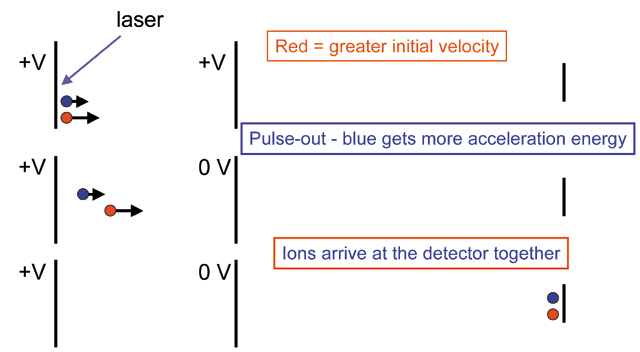
Delayed extraction
Encyclopedia

Electron ionization
Electron ionization is an ionization method in which energetic electrons interact with gas phase atoms or molecules to produce ions...
or Resonance enhanced multiphoton ionization in some narrow space between two plates of the ion extraction system. The extraction delay can produce time-of-flight compensation for ion energy spread and improve mass resolution.
Implementation
Resolution can be improved in time-of-flight mass spectrometer with ions produced at high vacuum conditions (better than few microTorr) by allowing the initial packet ions to spread in space due to their translational energy before being accelerated into the flight tube. With ions produced by electron ionizationElectron ionization
Electron ionization is an ionization method in which energetic electrons interact with gas phase atoms or molecules to produce ions...
or laser ionization of atoms or molecules from a rarefied gas, this is referred to as "time-lag focusing". With ions produced by laser desorption/ionization or MALDI from a conductive surface of target plate, this is referred as "delayed extraction."
With delayed extraction, the mass resolution is improved due to the correlation between velocity and position of the ions after those have been produced in the ion source. Ions produced with greater kinetic energy
Kinetic energy
The kinetic energy of an object is the energy which it possesses due to its motion.It is defined as the work needed to accelerate a body of a given mass from rest to its stated velocity. Having gained this energy during its acceleration, the body maintains this kinetic energy unless its speed changes...
have a higher velocity
Velocity
In physics, velocity is speed in a given direction. Speed describes only how fast an object is moving, whereas velocity gives both the speed and direction of the object's motion. To have a constant velocity, an object must have a constant speed and motion in a constant direction. Constant ...
and during the delay time move closer to the extraction electrode before the accelerating voltage is applied across the target or pulsed electrode. The slower ions with less kinetic energy stay closer to a surface of the target electrode or pulsed electrode when the accelerating voltage is applied and therefore start being accelerated at a greater potential compared to the ions farther from the target electrode. With the proper delay time, the slower ions will receive enough extra potential energy to catch the faster ions after flying some distance from the pulsed acceleration system. Ions of the same mass-to-charge ratio will then drift through the flight tube to the detector in the same time.

